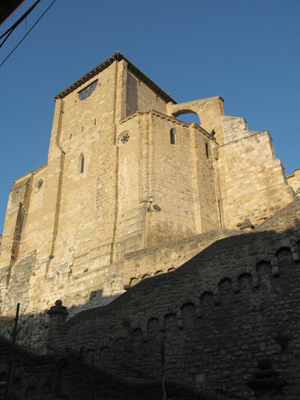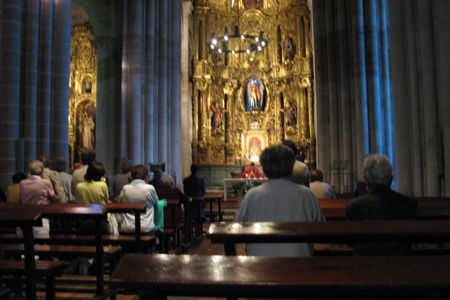| |
 |
 |
 |
| Comment on this report, or find other reports. |
 |
| Our Mystery Worshippers are volunteers who warm church pews for us around the world. If you'd like to become a Mystery Worshipper, start here. |
 |
| Find out how to reproduce this report in your church magazine or website. |
|
|
| 1886: San Miguel,
Estella, Navarre, Spain |
 |
 |
 |
Mystery Worshipper:
Augustine the Aleut.
The church:
San Miguel, Estella, Navarre, Spain.
Denomination:
Roman Catholic, Archdiocese
of Pamplona and Tudela.
The building:
Constructed in the latter part of the 12th century by Sancho
VI (the Wise), with three naves. The carving of the tympanum
over the entrance is utterly incredible and spectacular; it
depicts Christ in majesty, surrounded by the symbols of the
four Evangelists and the Virgin Mary and St John as intercessors
at the moment of judgment. The images inside are likewise worthy
of a visit. The exterior cloister has decorated capitals that
narrate the life of Our Lord and various saints, along with
plants and animal reliefs. The figures at the top of the capitals
are savage and humourous and energetic, and make one feel like
an effete milksop. To contrast this, the interior features a
17th century retablo, with freshly cleaned gold and painting,
so bright that it seemed afire and alight. Carving is primitive
and Gothic, evocative of a society emerging from the shades
of the dark ages – but vigorous, expressing itself and
its beliefs. There were about 200 or so steps up from the street
and I wondered how they dealt with access for the disabled,
but I found that there was a plaza at the other entrance that
was level with the floor of the church.
The church:
San Miguel is the oldest church in this ancient capital of Navarre
(which had a lot of ancient capitals; governments were not as
fixed in place as we are accustomed to). The kings of Navarre
traditionally recognised the liberties of the city and province
in this church. In 1872 the Carlist pretender Carlos VII took
the same oath here.
The neighbourhood:
Estella is in northern Spain, southwest of Pamplona, and features
many fine examples of Romanesque architecture. The church is
the eastern end of the town, just over the river by the medieval
footbridge, and is the poorer end of the older part of Estella.
There are shops with apartments above them; restaurants, bars
and hotels tend to be almost a kilometre to the west.
The cast:
David Galarza Fernández is the rector, but I am not certain
if he was the celebrant.
The date & time:
Friday, 25 September 2009, 7.00pm.
What was the name of the service?
Evening Mass.
How full was the building?
There were 42 men and 78 women in the church; about 10 were
in their teens, possibly killing time until the basketball game
and fiesta began in the courtyard outside. The nave could likely
fit about 200.
Did anyone welcome you personally?
I received the usual friendly but curious glances as I took
my seat. They don't do greeters in Navarre – and this was not
the church the pilgrims usually attend (too many steps!).
Was your pew comfortable?
I can't remember. I was about 10 pews from the front.
How would you describe the pre-service
atmosphere?
It was expectant and tranquil; noise from the preparations for
the fiesta wafted in from the plaza outside.
What were the exact opening
words of the service?
"En el nombre del Padre, y del Hijo, y del Espíritu
Santo."
What books did the congregation
use during the service?
Nothing that I noticed.
What musical instruments were played?
None, but there was an a cappella hymn during the communion.

Did anything distract
you?
Nothing really – I was still trying to catch my breath after
the walk up the steps. I wondered why the priest was wearing
red vestments (with a fine cloth-of-gold orphrey) during Trinitytide
until I realised that we were celebrating the feast day of San
Fermín, co-patron of Navarre along with St Francis Xavier.
Fermín was baptised by St Saturninus, who was martyred
in AD 257 by being dragged to death by a bull to which his feet
had been tied. The martyrdom of Saturninus has somehow been
transferred to Fermín, thus associating him with the
famous encierro, or running of the bulls, that takes
place every year in nearby Pamplona during the Sanfermines,
the festival of San Fermín that lasts from 6 to
14 July. San Fermín himself was martyred in AD 303.
Was the worship stiff-upper-lip,
happy clappy, or what?
It was the usual novus ordo mass, brisk and formal and friendly,
in the Spanish manner. After it finished, the priest brought
down a relic of San Fermín for parishioners to venerate.
Exactly how long was the
sermon?
5 to 6 minutes.
On a scale of 1-10, how good was the preacher?
7 – Based on the priest's diction and presentation, even
if I understood only a small part of his Spanish.
In a nutshell, what was
the sermon about?
I could not follow it all, but it was about how San Fermín
had come to them as a foreigner bearing the good news. They
had been the beneficiaries of the goodness of a stranger and
should remember this when they encounter strangers in their
midst, especially those who come to help with the harvest. There
was no mention of the running of the bulls.
Which part of the service
was like being in heaven?
I had a sensation of being part of a history of focus and worship
in this place. Afterward, I wondered about the little bit of
San Fermín in the reliquary.
And which part was like
being in... er... the other place?
Nothing, really. Although relic veneration is not my scene,
the locals seemed to take it in their stride.
What happened when you hung around after the service looking lost?
Not much. I went into the sacristy to get my pilgrim's credential
stamped and had a brief chat with the priest. He quickly identified
me as an Anglophone and we had a conversation in English about
Montserrat, from where I had begun to walk. He was very pleased
that Anglicans had such a devotion to Our Lady and I felt compelled
to mention that it was not universal, which elicited a smile.
I smiled back.
How would you describe
the after-service coffee?
Two women, one a tiny crone of an age to have watched Franco's
hyena-like troops enter in 1937, and the other a strapping student
in her late teens, came over to me as I walked into the plaza
and invited me to sit with their family for the fiesta. Resistance
was futile. Their dozen or so relations had no intention of
allowing language to be a barrier. An unlabelled bottle of rosé
cava was placed in front of me, along with a mountain of
grilled squid and garlic. Paella came, and I was urged to eat,
as the only good paella (they said) was paella a la casa,
made for the family. I could not argue. It was excellent, as
was the tomato salad, the lamb that followed, the crisp quail,
and the heap of watermelon and cheese. Again, unmarked bottles
came out, this time of the local firewater (I did not need to
floss for three days). San Fermín was toasted, as were
pilgrims, as was the priest, as were the musicians, as were
the daughters of the house, as was Canada, and Navarre, and
Spain. I have a vague memory of the king receiving a toast as
well, and perhaps MichaŽlle Jean (Governor General of Canada).
I do not know why Anglican parishes do not adopt this godly
custom of hospitality for strangers. I got back to my hotel
not too far after midnight – I think.
How would you feel about
making this church your regular (where 10 = ecstatic, 0 = terminal)?
8 – While medieval, it was comfortable. The priest was
literate and engaging, and the working class residents were
friendly and matter of fact. The after-service meal was not
a regular event, but it was hard to forget, even if the recollection
is fuzzy in detail.
Did the service make you feel glad to be a
Christian?
The feeling of community was something absent from my parish life for some time now, so this was welcome to me.
What one thing will you remember about all this in seven days' time?
The piercing and inquisitive eyes of the priest, and being surrounded by a family who seemed to think that I was the most interesting thing they had seen for decades. I am still surprised (and perhaps a bit sorry) that they did not marry me off to one of their daughters.
More Camino reports |
|
|
 |
 |
 |
| We rely on voluntary donations to stay online. If you're a regular visitor to Ship of Fools, please consider supporting us. |
 |
 |
 |
| The Mystery Pilgrim |
 |
| One of our most seasoned reporters makes the Camino pilgrimage to Santiago de Compostela in Spain. Read here. |
 |
 |
 |
| London churches |
 |
| Read reports from 70 London churches, visited by a small army of Mystery Worshippers on one single Sunday. Read here. |
| |
|
|
|
|


